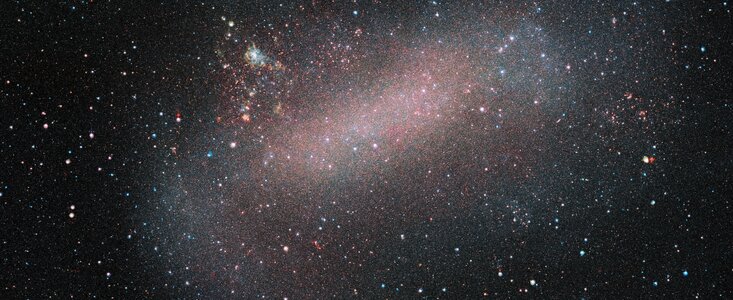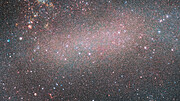Press Release
VISTA Unveils a New Image of the Large Magellanic Cloud
13 September 2019
ESO’s VISTA telescope reveals a remarkable image of the Large Magellanic Cloud, one of our nearest galactic neighbours. VISTA has been surveying this galaxy and its sibling the Small Magellanic Cloud, as well as their surroundings, in unprecedented detail. This survey allows astronomers to observe a large number of stars, opening up new opportunities to study stellar evolution, galactic dynamics, and variable stars.
The Large Magellanic Cloud, or LMC, is one of our nearest galactic neighbors, at only 163 000 light years from Earth. With its sibling the Small Magellanic Cloud, these are among the nearest dwarf satellite galaxies to the Milky Way. The LMC is also the home of various stellar conglomerates and is an ideal laboratory for astronomers to study the processes that shape galaxies.
ESO’s VISTA telescope, has been observing these two galaxies for the last decade. The image presented today is the result of one of the many surveys that astronomers have performed with this telescope. The main goal of the VISTA Magellanic Clouds (VMC) Survey has been to map the star formation history of the Large and Small Magellanic Clouds, as well as their three-dimensional structures.
VISTA was key to this image because it observes the sky in near-infrared wavelengths of light. This allows it to see through clouds of dust that obscure parts of the galaxy. These clouds block a large portion of visible light but are transparent at the longer wavelengths VISTA was built to observe. As a result, many more of the individual stars populating the centre of the galaxy are clearly visible. Astronomers analysed about 10 million individual stars in the Large Magellanic Cloud in detail and determined their ages using cutting-edge stellar models[1]. They found that younger stars trace multiple spiral arms in this galaxy.
For millennia, the Magellanic Clouds have fascinated people in the Southern Hemisphere, but they were largely unknown to Europeans until the Age of Discovery. The name we use today harkens back to the explorer Ferdinand Magellan, who 500 years ago began the first circumnavigation of the Earth. The records the expedition brought back to Europe revealed many places and things to Europeans for the first time. The spirit of exploration and discovery is ever more live today in the work of astronomers around the world, including the VMC Survey team whose observations led to this stunning image of the LMC.
Notes
[1] Stellar models allow astronomers to predict the life and death of stars, providing insights into properties like their ages, mass, and temperature.
More information
The stars revealed by this image were discussed in the paper “The VMC Survey - XXXIV. Morphology of Stellar Populations in the Magellanic Clouds” to appear in the journal Monthly Notices of the Royal Astronomical Society.
ESO is the foremost intergovernmental astronomy organisation in Europe and the world’s most productive ground-based astronomical observatory by far. It has 16 Member States: Austria, Belgium, Czechia, Denmark, France, Finland, Germany, Ireland, Italy, the Netherlands, Poland, Portugal, Spain, Sweden, Switzerland and the United Kingdom, along with the host state of Chile and with Australia as a Strategic Partner. ESO carries out an ambitious programme focused on the design, construction and operation of powerful ground-based observing facilities enabling astronomers to make important scientific discoveries. ESO also plays a leading role in promoting and organising cooperation in astronomical research. ESO operates three unique world-class observing sites in Chile: La Silla, Paranal and Chajnantor. At Paranal, ESO operates the Very Large Telescope and its world-leading Very Large Telescope Interferometer as well as two survey telescopes, VISTA working in the infrared and the visible-light VLT Survey Telescope. Also at Paranal ESO will host and operate the Cherenkov Telescope Array South, the world’s largest and most sensitive gamma-ray observatory. ESO is also a major partner in two facilities on Chajnantor, APEX and ALMA, the largest astronomical project in existence. And on Cerro Armazones, close to Paranal, ESO is building the 39-metre Extremely Large Telescope, the ELT, which will become “the world’s biggest eye on the sky”.
Links
Contacts
Maria-Rosa Cioni
Leibniz-Institut für Astrophysik Potsdam (AIP)
Potsdam, Germany
Tel: +49 331 7499 651
Email: mcioni@aip.de
Mariya Lyubenova
ESO Head of Media Relations
Garching bei München, Germany
Tel: +49 89 3200 6188
Email: pio@eso.org
About the Release
| Release No.: | eso1914 |
| Name: | Large Magellanic Cloud |
| Type: | Local Universe : Galaxy : Type : Irregular |
| Facility: | Visible and Infrared Survey Telescope for Astronomy |
| Instruments: | VIRCAM |
| Science data: | 2019MNRAS.490.1076E |
Our use of Cookies
We use cookies that are essential for accessing our websites and using our services. We also use cookies to analyse, measure and improve our websites’ performance, to enable content sharing via social media and to display media content hosted on third-party platforms.
ESO Cookies Policy
The European Organisation for Astronomical Research in the Southern Hemisphere (ESO) is the pre-eminent intergovernmental science and technology organisation in astronomy. It carries out an ambitious programme focused on the design, construction and operation of powerful ground-based observing facilities for astronomy.
This Cookies Policy is intended to provide clarity by outlining the cookies used on the ESO public websites, their functions, the options you have for controlling them, and the ways you can contact us for additional details.
What are cookies?
Cookies are small pieces of data stored on your device by websites you visit. They serve various purposes, such as remembering login credentials and preferences and enhance your browsing experience.
Categories of cookies we use
Essential cookies (always active): These cookies are strictly necessary for the proper functioning of our website. Without these cookies, the website cannot operate correctly, and certain services, such as logging in or accessing secure areas, may not be available; because they are essential for the website’s operation, they cannot be disabled.
Functional Cookies: These cookies enhance your browsing experience by enabling additional features and personalization, such as remembering your preferences and settings. While not strictly necessary for the website to function, they improve usability and convenience; these cookies are only placed if you provide your consent.
Analytics cookies: These cookies collect information about how visitors interact with our website, such as which pages are visited most often and how users navigate the site. This data helps us improve website performance, optimize content, and enhance the user experience; these cookies are only placed if you provide your consent. We use the following analytics cookies.
Matomo Cookies:
This website uses Matomo (formerly Piwik), an open source software which enables the statistical analysis of website visits. Matomo uses cookies (text files) which are saved on your computer and which allow us to analyze how you use our website. The website user information generated by the cookies will only be saved on the servers of our IT Department. We use this information to analyze www.eso.org visits and to prepare reports on website activities. These data will not be disclosed to third parties.
On behalf of ESO, Matomo will use this information for the purpose of evaluating your use of the website, compiling reports on website activity and providing other services relating to website activity and internet usage.
Matomo cookies settings:
Additional Third-party cookies on ESO websites: some of our pages display content from external providers, e.g. YouTube.
Such third-party services are outside of ESO control and may, at any time, change their terms of service, use of cookies, etc.
YouTube: Some videos on the ESO website are embedded from ESO’s official YouTube channel. We have enabled YouTube’s privacy-enhanced mode, meaning that no cookies are set unless the user actively clicks on the video to play it. Additionally, in this mode, YouTube does not store any personally identifiable cookie data for embedded video playbacks. For more details, please refer to YouTube’s embedding videos information page.
Cookies can also be classified based on the following elements.
Regarding the domain, there are:
- First-party cookies, set by the website you are currently visiting. They are stored by the same domain that you are browsing and are used to enhance your experience on that site;
- Third-party cookies, set by a domain other than the one you are currently visiting.
As for their duration, cookies can be:
- Browser-session cookies, which are deleted when the user closes the browser;
- Stored cookies, which stay on the user's device for a predetermined period of time.
How to manage cookies
Cookie settings: You can modify your cookie choices for the ESO webpages at any time by clicking on the link Cookie settings at the bottom of any page.
In your browser: If you wish to delete cookies or instruct your browser to delete or block cookies by default, please visit the help pages of your browser:
Please be aware that if you delete or decline cookies, certain functionalities of our website may be not be available and your browsing experience may be affected.
You can set most browsers to prevent any cookies being placed on your device, but you may then have to manually adjust some preferences every time you visit a site/page. And some services and functionalities may not work properly at all (e.g. profile logging-in, shop check out).
Updates to the ESO Cookies Policy
The ESO Cookies Policy may be subject to future updates, which will be made available on this page.
Additional information
For any queries related to cookies, please contact: pdprATesoDOTorg.
As ESO public webpages are managed by our Department of Communication, your questions will be dealt with the support of the said Department.








